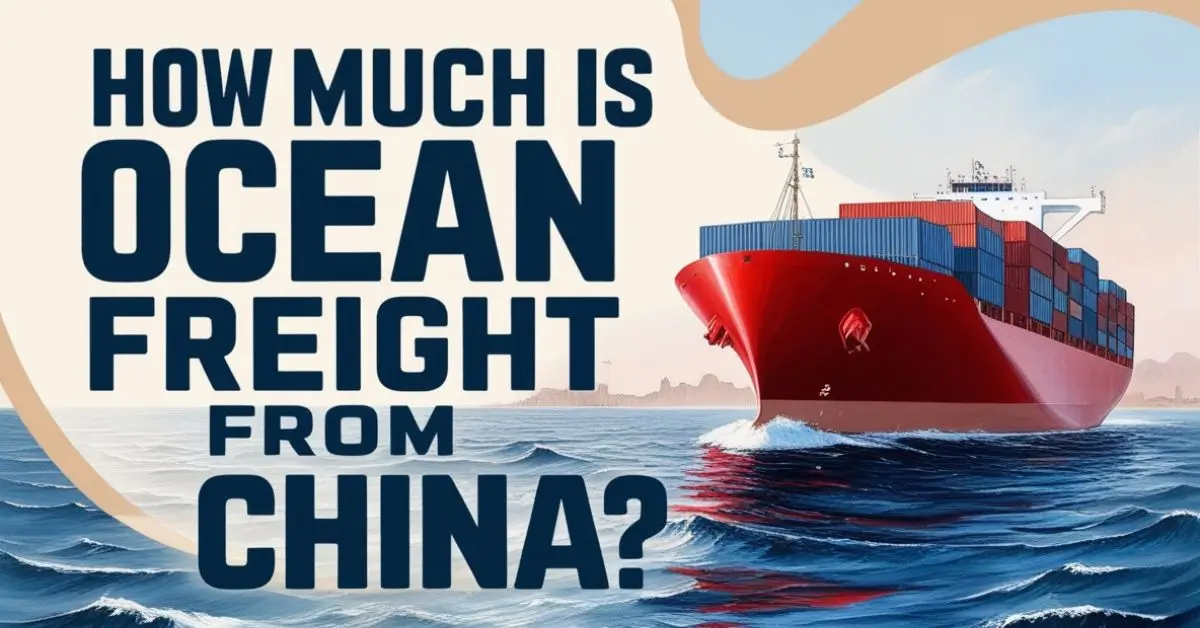How much is ocean freight from China? This is a key question for businesses and importers worldwide, as shipping costs directly impact profitability and supply chain efficiency. Ocean freight remains the most economical method of transporting goods internationally, but rates fluctuate based on various factors, including fuel prices, global demand, port congestion, and geopolitical events.
Understanding these cost influencers and planning shipments strategically can help businesses reduce expenses and improve logistics management. In this comprehensive guide, we explore the key aspects of ocean freight from China, compare shipping rates, and provide strategies to optimize costs.
Profile Summary
| Aspect | Details |
|---|---|
| Shipping Methods | Full Container Load (FCL) and Less than Container Load (LCL) |
| Key Cost Factors | Fuel prices, seasonal demand, port congestion, trade policies |
| Current Trends | Decreasing freight rates due to reduced demand and vessel overcapacity |
| Transit Time | Typically 20 to 45 days, depending on route and destination |
| Cost Optimization | Advance booking, choosing the right shipping mode, negotiating with carriers |
Factors Influencing Ocean Freight Rates from China
Several elements impact ocean freight pricing, making costs unpredictable at times. Here are the main factors that contribute to price fluctuations:
Fuel Prices
Fuel costs are one of the most significant factors affecting shipping rates. When fuel prices rise, freight charges increase accordingly. Carriers adjust fuel surcharges based on global crude oil prices, which can lead to sudden rate changes.
Seasonal Demand
Certain periods experience higher shipping demand, such as the months leading up to major shopping seasons like Christmas and Chinese New Year. During these times, ocean freight rates often surge due to limited container availability and increased bookings.
Geopolitical Events and Trade Policies
Global trade policies, tariffs, and political tensions can disrupt shipping lanes and influence costs. Import restrictions, trade sanctions, and new tariffs on goods can lead to increased expenses for shippers. Additionally, military conflicts or blockades in key shipping routes can cause delays and additional surcharges.
Port Congestion and Operational Delays
Congested ports result in longer waiting times for vessels, leading to additional charges such as demurrage and detention fees. Busy ports in China, such as Shanghai and Shenzhen, often experience congestion, especially during peak seasons.
Shipping Route and Distance
The cost of ocean freight also depends on the shipping route and final destination. Longer routes with multiple transshipments tend to be more expensive due to additional handling and fuel consumption.
Container Availability
A shortage of containers, especially for certain shipping routes, can push rates higher. In contrast, an oversupply of containers leads to decreased freight costs. Market conditions and trade imbalances between countries influence container availability.
Current Trends in Ocean Freight Rates from China
In recent months, ocean freight rates from China have experienced fluctuations. A decline in global shipping demand, combined with increased vessel availability, has led to lower rates for many destinations.
For example, freight rates from China to Europe and North America have dropped compared to peak pandemic levels. This downward trend is driven by factors such as:
- Lower consumer demand in key markets
- Increased capacity from new vessel deliveries
- Reduced supply chain disruptions compared to previous years
However, certain unpredictable events—such as natural disasters or sudden geopolitical conflicts—can still cause temporary rate hikes. Businesses must stay informed about market conditions to make cost-effective shipping decisions.
Comparison of Ocean Freight Rates from China
Below is a general comparison of ocean freight rates from China to major global destinations. These rates are based on recent trends and may fluctuate due to market conditions.
| Destination | Rate per 40′ Container | Transit Time | Key Considerations |
|---|---|---|---|
| Los Angeles, USA | $4,500 – $5,000 | 18-30 days | High demand during holiday seasons |
| New York, USA | $6,000 – $6,500 | 25-40 days | Longer transit due to Panama Canal or Suez routes |
| Rotterdam, EU | $3,200 – $3,500 | 30-45 days | Rates fluctuate based on European demand |
| Sydney, AUS | $3,800 – $4,200 | 20-35 days | Lower container availability at times |
| Dubai, UAE | $2,700 – $3,200 | 18-30 days | Lower demand but potential geopolitical risks |
These rates serve as a general reference, and actual costs may vary depending on shipping carriers, contracts, and market conditions.
How to Reduce Ocean Freight Costs from China
While ocean freight is generally cost-effective, businesses can take additional steps to reduce expenses and improve efficiency. Here are some effective strategies:
Choose the Right Shipping Mode
Selecting the appropriate shipping method is crucial:
- Full Container Load (FCL): Ideal for large shipments, offering cost savings per unit.
- Less than Container Load (LCL): Best for smaller shipments but may have higher costs per cubic meter due to consolidation fees.
Book Shipments in Advance
Advance booking helps secure better rates, especially during peak shipping seasons. Waiting until the last minute often results in higher prices due to increased demand.
Optimize Packaging and Container Utilization
Efficiently packing goods and maximizing container space can reduce overall costs. Using standardized pallets and stackable cargo helps optimize space utilization.
Compare Multiple Freight Forwarders
Different shipping companies offer varying rates and service levels. Comparing multiple freight forwarders can help secure the best deal.
Stay Updated on Market Trends
Freight rates fluctuate based on supply and demand. Keeping track of market trends allows businesses to plan shipments strategically and take advantage of lower rates when possible.
Consolidate Shipments
For smaller shipments, consolidating multiple orders into a single container can help lower costs. Freight consolidation services allow businesses to share container space and reduce per-unit shipping expenses.
Negotiate Long-Term Contracts
Establishing long-term contracts with shipping carriers or freight forwarders can provide more stable rates, reducing the impact of seasonal price hikes.
Conclusion
How much is ocean freight from China? The answer depends on multiple factors, including fuel prices, seasonal demand, shipping routes, and global economic conditions. While rates fluctuate, businesses can take proactive steps to optimize costs by choosing the right shipping mode, booking in advance, and staying informed about market trends.
By understanding cost influences and employing strategic shipping practices, businesses can make well-informed decisions that enhance their supply chain efficiency and profitability.
FAQs
How long does ocean freight from China take?
Transit times vary between 20 and 45 days, depending on the destination and chosen shipping route.
What is the difference between FCL and LCL shipping?
FCL (Full Container Load) is a dedicated container for one shipper, while LCL (Less than Container Load) involves sharing a container with multiple shippers.
How can I get the lowest ocean freight rates from China?
Booking in advance, consolidating shipments, comparing freight forwarders, and negotiating long-term contracts can help lower costs.
Why do ocean freight rates fluctuate?
Rates change due to fuel prices, seasonal demand, port congestion, geopolitical events, and global economic conditions.
What are demurrage and detention charges?
Demurrage fees apply when a container stays at the port beyond the free period, while detention charges occur when containers are held outside the port longer than allowed.
Is ocean freight cheaper than air freight?
Yes, ocean freight is significantly cheaper than air freight, especially for bulk shipments, but it takes longer for goods to arrive.












